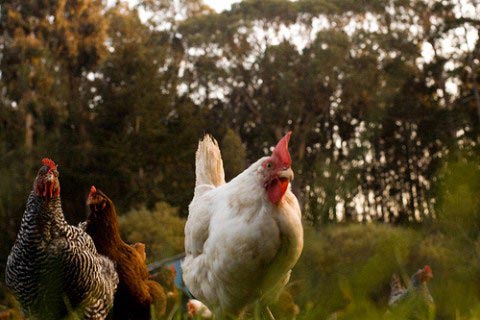Chicken has amazing visual ability
Researchers from the Department of Medicine, University of Washington, USA, have discovered chicken eyes with incredible visual ability, opening up research directions for treating visual diseases in humans.
Scientists have identified five types of light receptors in chicken eyes. They also discovered that the senses intertwined to maximize the visibility of the chickens, to be able to see more colors in any part of the eyeball - the light-sensing structure in the latter. of the eye. Double cone receptors also help determine better movement. The study is published in PLoS One.
"Based on this analysis, birds have a higher color vision than our species. The organization of color receptors in chicken eyeballs helps them outperform, like most mammals. " , Dr. Joseph Corbo, team leader in pathology, immunology and genetics.
Corbo intends to conduct further research to explain how the receptor organization is set up. He said that a thorough understanding of this issue could help scientists continue to study the use of stem cells and other techniques in treating nearly 200 genetic disorders that produce these types of diseases. vision like blindness.
Birds possess large color vision because they do not have to go through an evolutionary period of history in the dark. Because although they share a common ancestor with reptiles and mammals, during the dinosaurs, most mammals become nocturnal for millions of years, and birds do not.

Chicken eyeballs contain receptors that can sense purple wavelengths.
Night vision due to rod shaped receptors, developed in the eyes of mammals during the dinosaur period; and daytime vision based on cone receptor type. Birds have more types of cones than mammals.
"Human eyeballs have cones that sense red, green and blue wavelengths. The bird's eyeball has more cells that can receive violet wavelengths, including some ultraviolet rays; especially a couple of double cones help them detect small movements, " Corbo explained.
The team found many types of cone cells distributed on the eyeball, but what is special is that the two cones of the same type never overlap. This helps to form color areas in their visual field. Corbo also emphasized the effect of special light sensitivity to help birds find partners, colorful birds, or when feeding on colorful fruits and fruits.
"Many factors due to genetic conditions that cause human blindness affect cone and rod cells, studying the organization on chicken eyeballs can help us better understand and correct problems. about our eyes , " Corbo said.
- Chicken thighs: West doesn't like why we like it?
- People should not eat chicken
- Why are Thai chicken prices
- Should eating white chicken or brown chicken?
- Why chicken eggs have two colors and the reason is unexpected
- Many mistakes when people boil or roast chicken
- The strange beauty of Silkie chickens looks like
- More than an illusion - this photo gives you an unexpected benefit
- Guaranteed visual fool beams will surprise you
- Vietnam is still testing fresh 6 month chicken preservation
- How to deal with chicken bones
- Chicken with bag
 Animal 'suffering' after hibernation
Animal 'suffering' after hibernation Why do goats climb well?
Why do goats climb well? Scientists were surprised to see chimpanzees eating turtles
Scientists were surprised to see chimpanzees eating turtles Giant catfish died deadly due to drought in Thailand
Giant catfish died deadly due to drought in Thailand Why can migratory birds fly thousands of kilometers without eating?
Why can migratory birds fly thousands of kilometers without eating?  When it rains, where do the birds take shelter?
When it rains, where do the birds take shelter?  100 years ago, a man released 60 strange birds, causing the US to lose $1 billion a year.
100 years ago, a man released 60 strange birds, causing the US to lose $1 billion a year.  Ancient Egyptian masterpiece so realistic that scientists accurately identified the birds in the painting
Ancient Egyptian masterpiece so realistic that scientists accurately identified the birds in the painting  Scientists plan to turn dead birds into drones
Scientists plan to turn dead birds into drones  Why did birds survive while dinosaurs became extinct?
Why did birds survive while dinosaurs became extinct? 